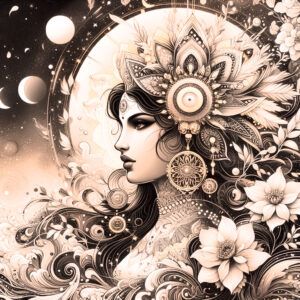
CONCEPT:
Tantra
Pronunciation:
/ˈtʌntrə/
Definition:
Tantra is a complex and esoteric spiritual tradition originating in ancient India, characterized by its emphasis on ritual practices, symbolism, and the integration of seemingly opposing forces.
Other Concepts
Deeper Understanding
Deep in the heart of ancient India, a mystical tradition arose, one that embraced paradox and sought to expand human consciousness beyond the boundaries of the ordinary. Tantra, often shrouded in secrecy and whispered about in hushed tones, is a spiritual path that weaves together diverse practices, philosophies, and rituals into a cohesive framework designed to transcend the mundane and access the divine.
Tantra’s roots trace back to the Vedic and Brahmanical traditions, but it blossomed into its own unique flower over time. The term itself, derived from the Sanskrit “tan,” meaning “to stretch” or “to extend,” hints at its core philosophy: the expansion of the self and the quest for union with the divine. It represents an intricate system that challenges practitioners to integrate and harmonize seemingly opposing forces, such as male and female, body and spirit, and creation and destruction.
Tantric practices are a rich tapestry, incorporating mandalas (sacred geometric diagrams), mantras (sacred sounds), visualization techniques, and even the veneration of fierce deities. These practices are not merely symbolic but are believed to directly engage and manipulate cosmic energies. The yantra, a key component in Tantra, is a geometric diagram used as a tool for meditation, helping practitioners focus and channel spiritual energy.
One of the most intriguing aspects of Tantra is its approach to sexuality. Contrary to popular misconceptions, Tantric sexuality is not about indulgence but about the sacredness and spiritual potential of sexual energy. By harnessing this energy, practitioners aim to achieve higher states of consciousness and ultimately, spiritual liberation.
Throughout its history, Tantra has been a subject of fascination and misunderstanding. Early Western scholars like John Woodroffe sought to peel back the layers of secrecy, revealing a tradition steeped in ethical principles and philosophical depth. His works provided a window into the complex rituals and esoteric knowledge that define Tantra, emphasizing its profound spiritual and psychological insights.
In the modern era, Tantra continues to intrigue and inspire. It challenges conventional notions of spirituality, offering a path that embraces both the light and shadow aspects of human existence. While its esoteric nature may seem daunting to some, Tantra invites those who seek a deeper understanding of themselves and the universe to embark on a transformative journey. The practice of Tantra is not just about esoteric rituals; it’s a profound way to explore the interconnectedness of all things and the potential for profound personal and spiritual growth.
Tantra is a multifaceted tradition that has captivated seekers for centuries. Its emphasis on ritual, symbolism, and the integration of opposites provides a unique approach to spiritual exploration. As scholars continue to delve into its depths, Tantra’s relevance in the modern world becomes increasingly apparent, offering insights into the human psyche and the interconnectedness of all things.
References
Flood, Gavin. An Introduction to Hinduism. Cambridge University Press, 1996.
Padoux, André. “Tantra.” In Eliade, Mircea (ed.). The Encyclopedia of Religion, vol. 14. Macmillan, 1987.
White, David Gordon (ed.). Tantra in Practice. Princeton University Press, 2000.
Woodroffe, John. The Serpent Power: The Secrets of Tantric and Shaktic Yoga. Ganesh & Co., 1919.

